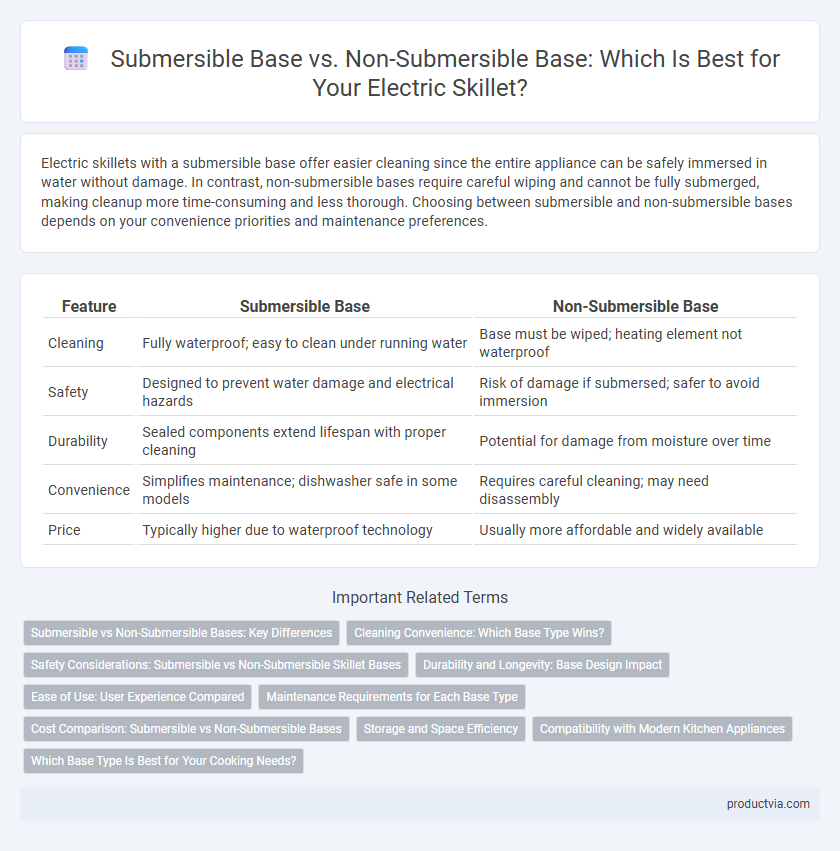Electric skillets with a submersible base offer easier cleaning since the entire appliance can be safely immersed in water without damage. In contrast, non-submersible bases require careful wiping and cannot be fully submerged, making cleanup more time-consuming and less thorough. Choosing between submersible and non-submersible bases depends on your convenience priorities and maintenance preferences.
Table of Comparison
| Feature | Submersible Base | Non-Submersible Base |
|---|---|---|
| Cleaning | Fully waterproof; easy to clean under running water | Base must be wiped; heating element not waterproof |
| Safety | Designed to prevent water damage and electrical hazards | Risk of damage if submersed; safer to avoid immersion |
| Durability | Sealed components extend lifespan with proper cleaning | Potential for damage from moisture over time |
| Convenience | Simplifies maintenance; dishwasher safe in some models | Requires careful cleaning; may need disassembly |
| Price | Typically higher due to waterproof technology | Usually more affordable and widely available |
Submersible vs Non-Submersible Bases: Key Differences
Submersible bases on electric skillets are designed to be fully immersed in water for easy and thorough cleaning, enhancing hygiene and convenience. Non-submersible bases require careful cleaning around electrical components, necessitating spot cleaning that preserves the integrity of the heating element and wiring. Choosing between submersible and non-submersible bases impacts maintenance, safety, and overall user experience in electric skillet operation.
Cleaning Convenience: Which Base Type Wins?
A submersible base electric skillet offers unparalleled cleaning convenience by allowing the entire unit, including the base, to be safely immersed in water, simplifying the cleanup process. Non-submersible base models require careful cleaning around the heating element to avoid water damage, often necessitating manual wiping and restricted washing options. For users prioritizing ease and thoroughness in maintenance, electric skillets with submersible bases are the superior choice.
Safety Considerations: Submersible vs Non-Submersible Skillet Bases
Submersible electric skillet bases allow full immersion in water for cleaning, reducing the risk of electric shock when used correctly and ensuring safe maintenance. Non-submersible bases require careful wiping around electrical components, as exposure to water can cause short circuits or damage, increasing safety risks. Choosing a submersible base enhances overall kitchen safety by simplifying cleaning and minimizing electrical hazards.
Durability and Longevity: Base Design Impact
A submersible base in an electric skillet offers enhanced durability by allowing easy and thorough cleaning, reducing the risk of residue buildup that can damage the heating element over time. Non-submersible bases require careful wiping to avoid water damage, which may shorten the unit's lifespan due to potential electrical component exposure. Choosing a submersible base design significantly extends the skillet's longevity by protecting internal parts and maintaining optimal heating performance.
Ease of Use: User Experience Compared
A submersible base electric skillet offers easier cleaning since users can fully immerse the cooking pan in water without damaging the heating element, enhancing user convenience. Non-submersible base models require careful wiping and avoiding direct water contact, which can be less user-friendly and time-consuming. Choosing a submersible base improves overall ease of use by simplifying maintenance and reducing the risk of electrical damage during cleaning.
Maintenance Requirements for Each Base Type
Submersible bases in electric skillets allow for easier cleaning as the entire unit can be safely immersed in water, reducing residue buildup and simplifying maintenance. Non-submersible bases require more cautious cleaning to avoid damaging electrical components, often needing spot cleaning with a damp cloth and avoiding full immersion. Choosing between the two affects maintenance time and care intensity, with submersible bases offering more convenience for routine upkeep.
Cost Comparison: Submersible vs Non-Submersible Bases
Submersible base electric skillets typically cost more due to their enhanced waterproof design and ease of cleaning, which adds to production expenses. Non-submersible base models are generally more affordable but require careful handling during cleaning to avoid damage, reflecting lower manufacturing complexity. Consumers should weigh the initial cost against long-term maintenance convenience when choosing between these two types.
Storage and Space Efficiency
Electric skillets with a submersible base offer greater ease in cleaning but require separate drying space to prevent water damage, impacting storage efficiency. Non-submersible base models maintain compactness and reduce the risk of water-related issues, making them more space-efficient for storage in tight kitchens. Choosing between the two depends on balancing cleaning convenience with optimal use of kitchen storage and space constraints.
Compatibility with Modern Kitchen Appliances
Electric skillets with submersible bases offer enhanced compatibility with modern kitchen appliances by allowing easier cleaning and maintenance, which aligns well with the convenience-driven design of contemporary kitchens. Non-submersible base skillets require more cautious cleaning methods to avoid damaging electrical components, making them less compatible with the streamlined, multi-functional use expected in modern culinary setups. Choosing a skillet with a submersible base supports integration into smart and compact kitchen environments where ease of use and hygiene are prioritized.
Which Base Type Is Best for Your Cooking Needs?
A submersible base electric skillet offers easy cleaning by allowing the entire skillet to be immersed in water, making it ideal for frequent cooks seeking convenience and hygiene. Non-submersible base skillets require careful cleaning of the heating element but typically provide more robust construction and faster heat-up times, preferred by users prioritizing durability and performance. Choosing the best base type depends on your cooking habits, with submersible bases suited for ease of maintenance and non-submersible bases favored for heavy-duty cooking tasks.
Submersible base vs non-submersible base for electric skillet Infographic

 productvia.com
productvia.com